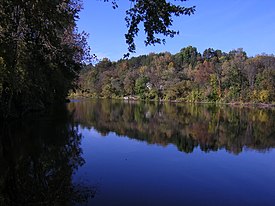Forest Hills is an unincorporated community and census-designated place (CDP) in Kent County in the U.S. state of Michigan. The population was 28,573 at the 2020 census, making it the most populous CDP in Michigan. It is also the largest CDP by area in the state of Michigan, encompassing nearly all of Ada Township and most of the northern half of Cascade Township. The Forest Hills Public Schools District serves most of the community.[4]
Forest Hills, Michigan | |
|---|---|
 The Grand River passing through Forest Hills | |
 Location within Kent County | |
| Coordinates: 42°56′54″N 85°29′32″W / 42.94833°N 85.49222°W | |
| Country | United States |
| State | Michigan |
| County | Kent |
| Townships | Ada and Cascade |
| Area | |
• Total | 50.80 sq mi (131.58 km2) |
| • Land | 49.30 sq mi (127.68 km2) |
| • Water | 1.51 sq mi (3.90 km2) |
| Elevation | 630 ft (192 m) |
| Population (2020) | |
• Total | 28,573 |
| • Density | 579.60/sq mi (223.78/km2) |
| Time zone | UTC-5 (Eastern (EST)) |
| • Summer (DST) | UTC-4 (EDT) |
| ZIP code(s) | |
| Area code | 616 |
| FIPS code | 26-29580[2] |
| GNIS feature ID | 1867318[3] |
Geography
editAccording to the U.S. Census Bureau, the CDP has a total area of 50.80 square miles (131.57 km2), of which 49.27 square miles (127.61 km2) are land and 1.53 square miles (3.96 km2) (3.01%) is water.[5]
The Grand River crosses the community from the east side to the northwest corner.
Major highways
editDemographics
edit| Census | Pop. | Note | %± |
|---|---|---|---|
| 2010 | 20,942 | — | |
| 2020 | 28,573 | 36.4% | |
| U.S. Decennial Census[6] | |||
2020 census
editAs of the 2020 United States census,[7] the area had a population of 28,573 people. The racial makeup was 87.5% Non-Hispanic White, 1.0% Black or African American, 4.3% Asian, 0.1% Native American, and 4.4% from two or more races. Hispanic or Latino people of any race were 4.3% of the population.
2000 census
editAs of the census[2] of 2000, there were 20,942 people, 7,105 households, and 6,046 families residing in the community. The population density was 424.0 inhabitants per square mile (163.7/km2). There were 7,371 housing units at an average density of 149.3 per square mile (57.6/km2). The racial makeup of the community was 95.28% White, 0.64% African American, 0.20% Native American, 2.63% Asian, 0.34% from other races, and 0.91% from two or more races. Hispanic or Latino of any race were 0.95% of the population.
There were 7,105 households, out of which 44.2% had children under the age of 18 living with them, 78.6% were married couples living together, 4.8% had a female householder with no husband present, and 14.9% were non-families. 12.7% of all households were made up of individuals, and 4.9% had someone living alone who was 65 years of age or older. The average household size was 2.94 and the average family size was 3.23.
In the community, the population was spread out, with 31.4% under the age of 18, 4.9% from 18 to 24, 25.6% from 25 to 44, 29.4% from 45 to 64, and 8.8% who were 65 years of age or older. The median age was 39 years. For every 100 females, there were 99.3 males. For every 100 females age 18 and over, there were 96.1 males.
The median income for a household in the community was $96,150 (2007 estimate[8]), and the median income for a family was $106,521. Males had a median income of $68,003 versus $37,553 for females. The per capita income for the community was $39,517. About 1.3% of families and 2.0% of the population were below the poverty line, including 1.7% of those under age 18 and 3.9% of those age 65 or over.
References
edit- ^ "2020 U.S. Gazetteer Files". United States Census Bureau. Retrieved May 21, 2022.
- ^ a b "U.S. Census website". United States Census Bureau. Retrieved January 31, 2008.
- ^ "US Board on Geographic Names". United States Geological Survey. October 25, 2007. Retrieved January 31, 2008.
- ^ Michigan Geographic Framework (November 15, 2013). "Kent County School Districts" (PDF). Archived (PDF) from the original on August 20, 2014. Retrieved April 28, 2021.
- ^ "Michigan: 2010 Population and Housing Unit Counts 2010 Census of Population and Housing" (PDF). 2010 United States Census. United States Census Bureau. September 2012. pp. 27–28 Michigan. Archived (PDF) from the original on October 19, 2012. Retrieved October 1, 2021.
- ^ "Census of Population and Housing". Census.gov. Retrieved June 4, 2016.
- ^ "U.S. Census website". United States Census Bureau. Retrieved May 9, 2024.
- ^ 2005–2007 American Community Survey 3-Year Estimates, United States Census Bureau

